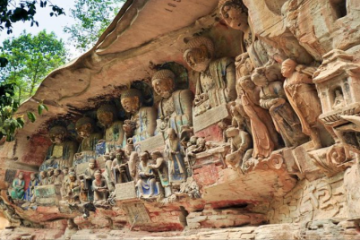The Beishan Stone Carvings, also known as the Beishan Rock Carvings, are a remarkable collection of Buddhist sculptures located in Dazu District, Chongqing, China. These carvings are part of the larger Dazu Rock Carvings, which were inscribed on the UNESCO World Heritage List in 1999. The Beishan Stone Carvings are renowned for their exquisite craftsmanship, detailed carvings, and the rich cultural and historical significance they embody.

The Beishan Stone Carvings are located on Beishan, anciently known as Longgang Mountain, approximately 1.5 kilometers north of the urban area of Dazu District. The carvings were initiated by Wei Junjing, the military governor of Changzhou, in 892 AD during the late Tang Dynasty and continued through the Five Dynasties and into the Southern Song Dynasty, spanning over 250 years. The carvings are divided into two main sections: the southern and northern segments, with a total of 290 niches and nearly 10,000 statues.
The Beishan Stone Carvings are notable for their diverse range of subjects and artistic styles. The carvings primarily feature Buddhist themes, with a significant emphasis on Bodhisattvas, particularly Guanyin, the Bodhisattva of Compassion. The sculptures reflect the transition of artistic styles from the Tang Dynasty to the Song Dynasty, showcasing a blend of traditional and evolving techniques. The late Tang Dynasty carvings are characterized by their robust and full-bodied figures, while the Song Dynasty carvings exhibit more delicate and refined features.
One of the most celebrated works at Beishan is the No. 136 Turning Wheel Sutra Repository Cave, which is considered the pinnacle of Beishan's artistic achievement. This cave, dating from the Southern Song Dynasty, features intricate carvings of Bodhisattvas and other Buddhist figures, renowned for their serene expressions and elaborate attire. The cave's central turning wheel symbolizes the eternal nature of Buddhist law, surrounded by figures that exemplify the artistic excellence of the period.
The Beishan Stone Carvings also include several important inscriptions and steles. The "Wei Junjing Stele," dating back to 895 AD, provides valuable historical insights into the late Tang Dynasty. Another notable inscription is the "Ancient Texts of the Classic of Filial Piety," which is considered a unique and significant historical document.
The Beishan Stone Carvings are not only a testament to the religious and cultural practices of their time but also a showcase of the artistic mastery of the sculptors. The detailed carvings, the variety of expressions, and the integration of Buddhist and local cultural elements make Beishan a vital site for understanding the development of Chinese stone carving art. Visitors to Beishan can experience the profound spiritual and aesthetic qualities of these ancient carvings, which continue to captivate and inspire.




































